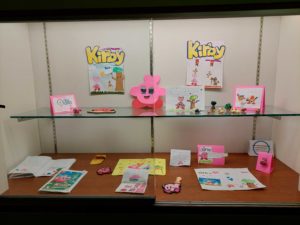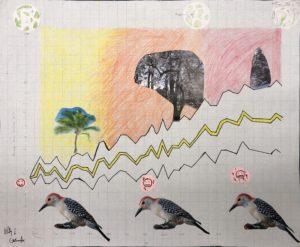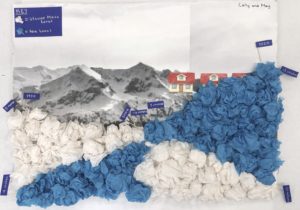Singularity is an art exhibit by local artist Hilde-Kari Guttormsen. Trained in Medicine, Science and Art, she has been a studio artist full time since she graduated from Massachusetts College of Art and Design in 2015. The exhibit will be on display at The Gallery in Hunneman Hall, Brookline Village Library, Second Floor, from April 1 through April 28, 2022. The works in the show allude to her upbringing in Western Norway and present a personal narrative using colors, gimp and acetate to humanize formal elegance. The closing reception is open to the public and will be in Hunneman Hall, Saturday, April 23, from 2-4:30 pm. Light refreshments will be served. Hilde-Kari Guttormsen has her studio in Lincoln Artist Group in Waltham and all the works in the show are for sale. Inquiries about the works and/or a studio visit can be arranged by contacting the artist by e-mail: hguttormsen@gmail.com or phone 617-462-2856.
Eevee’s Pokémon and Ollie’s Kirby Collection
This month Eeevee displays her collection of Pokémon art, cards, and figures in our flat case. She was named after the Pokémon Eevee and has been collecting Pokémon cards since she was four!

In our wall case, Ollie displays his collection of Kirby Perler art, hand-drawn comics, and sculpey. He even has a 3D printed mini-Kirby!
Stop by the Brookline Village Children’s Room to see both of these amazing collections! And sign up for a slot in our display cases here!
Titanic Then, Titanic Now
She was the Ship of Dreams. Titanic was the largest ship ever built, the most beautiful, supposedly the safest. And four days into her maiden voyage, she struck an iceberg and went down. More than two-thirds of those aboard her died with her.
Ever since, she’s been a story, a symbol, a metaphor for disaster—and an entertainment. The first movie about her was made only two weeks after she sank and starred a survivor, movie star Dorothy Gibson. She’s appeared in one of the most successful movies ever made; on TV in Family Guy, Dr. Who, and Encanto; and in Black popular music, including the subversive “Shine.” Fifty years after her wreck, she motivated a Massachusetts jeweler to write to all the survivors, collect a treasure of their memories, and found the Titanic Historical Society.
And, in 1985, her wreck was found.
Titanic Then, Titanic Now looks at Titanic as she was—a lovely dream for her first-class passengers, but segregated by race and class—and as she is now, an instantly recognizable piece of our lives. Some highlights from the exhibition:
- Souvenirs of first-class life in 1912, from perfumes to ship’s pins
- Prominent Jewish passengers and Titanic’s few Black passengers
- Mourning for Titanic, from postcards to bears
- How Titanic may have saved your life
- The last Massachusetts survivor
- Titanic in the movies, on TV, and as video games
- A postcard that went down to visit Titanic
- Titanic jokes and tchotchkes
Titanic Then, Titanic Now comes to us courtesy of Brookline author Sarah Smith, who’s written a novel about Titanic and its aftermath. William Martin says about Crimes and Survivors, “Read it and be enthralled!” You can order a signed copy through Brookline Booksmith or directly from Sarah through her Web site, www.sarahsmith.com .
Not everything can be fit into an exhibit case. Sarah’s put together some playlists of videos, music, and movies about Titanic.
General Titanic playlist:
https://tinyurl.com/TripOnTitanic
Titanic music on YouTube:
https://tinyurl.com/TitanicInMusic
and on Spotify:
https://tinyurl.com/SpotifyTitanic
Titanic movies–good, bad, and awful. Kate Winslet’s screen test and Owlkitty!
https://tinyurl.com/TitanicMovies
You can reach these all from:
https://www.sarahsmith.com/a-titanic-playlist.html
And on the same page, there’s a Titanic exhibit goody bag.
In-Person Storytimes are Back!
We’re so excited to read with you again!
Tool Library Now Open!
Have big DIY dreams but a somewhat less-big Brookline apartment? Save your space and a trip to the hardware store with this brand new collection of over 50 hand and power tools, including screwdriver sets, drills, saws, ladders, and a lot more exclusively at our Coolidge Corner location!
How does it work?
Almost exactly the same as checking out a book! Just:
- Place a hold on the tool you’d like to borrow. If you’d like to place a hold on multiple different tools, give our staff a call at 617-730-2380. You can also swing by in person to see what we have available.
- Wait for an email notification letting you know your tool is ready to pick up.
- Fill out a safety waiver at the desk, then check out the tool with your library card!
- Return tools to the Coolidge Corner Library during their open hours (please don’t put tools in the bookdrop!). All tools may be borrowed for up to two weeks and renewed if no one is waiting for them.
Food From Page to Pottery
Third and fourth grade students at the Florida Ruffin Ridley School have made food sculptures inspired by the author/illustrator Oge Mora.
Come by to see their creations (warning: it might make you hungry!) and find the books at the library.
Shared Habitat Earth
The effects of climate change are becoming ever more alarmingly clear. We are now seeing dramatic weather events all over the world, with disastrous consequences. Humanity, together with all living things, finds itself in grave danger.
Art can invite empathy and hope. It can keep us from becoming numb and from passively enduring what looks inevitable–and it can help us live up to our humanity by doing our part.
Shared Habitat Earth (SHE) is an exhibit series uniting more than 40 artists in and around Boston. It celebrates cross species respect, intercultural solidarity, and a shared sense of responsibility. Through painting, sculpture, fiber art, and photography, the artists of this exhibition dramatize the tension between what humanity has enjoyed for thousands of years, and what will be left if we don’t act now.
The artists with work on view at the Coolidge Corner Library are Agusta Agustsson, June August, Helen Canetta, Olivia Fischer Cox, Becky Kisabeth Gibbs, Bette Ann Libby, Preetha Mahadevan, Rebecca McGee Tuck, and Nora Charney Rosenbaum.
The artists appeared alongside representatives from local environmental organizations for a virtual panel on art and activism in April. Watch the recording of the event on our YouTube channel.
More information about the exhibit series, including a full list of dates and venues, is available on the SHE website.
Kids & Teens Reading Challenges
Want to earn awesome prizes for reading year-round? Check out our ongoing reading challenges for kids, tweens, and teens! We offer four programs tailored to different age groups to encourage and motivate young readers.
Our 1,000 Books Before Kindergarten program is geared for babies, toddlers, and preschoolers and can be started anytime before a child begins Kindergarten! Re-reads totally count, and the program is self-paced so you can take as little or as long of a time as you need.
Our 200 Books Before Middle School program is made for kids in grades Kindergarten to 5. Prizes are earned for every 50 books read and once again, the program is self-paced. Sign up any time before a child enters sixth grade!
Our 100 Books Before High School program is geared for kids in grades 6 to 8. This program includes a recommended reading list and extra fun prizes, and kids can be signed up at any time before they start high school.
Last but not least, our 100 Books Before Graduation program encourages teens to finish high school strong by reading 100 books. Teens in grades 9 to 12 can sign up to earn prizes as they read, with the goal of completing it before graduating high school.
Introducing ideaSPACE Make & Meet!
We’re so excited to announce that our Library To-Go Kits will now alternate months with ideaSPACE Make & Meet – a live, all-ages making program at the Brookline Village Library!
Want to make something awesome and meet the Library’s ideaSPACE tools up close? Then ideaSPACE Make & Meet is for you! These drop-in, hands-on activities are designed to give you a chance to ask questions and get creative with some of our favorite machines in the collection.
Join us for our first Make & Meet event Monday, March 14 at 7 PM to design your own laser cut magnet. This project is both kiddo- and grown-up-friendly, so the whole family is welcome to participate.
Visualizing Climate Change Data
Visit the Brookline Village Library Teen Room to see the vivid and beautiful art combining science data and visual media to show the effects of climate change. There are pieces hanging on the walls in the Teen Room as well as just outside near our display case and table.
Heath School Science Teacher Mark Golder explains the process of creating these works:
“Inspired by the work of scientist and artist Jill Pelto, 8th graders at the Heath School analyzed climate data and used this data to create pieces of art. Each piece represents one effect of climate change, and students incorporated graphs of data from that topic into their imagery.
“At the end of the project, students reflected on the process and recorded short screencasts, which you can watch by pointing your phone at the QR code on each artist statement. You can also go directly to the website with all of the student work and reflections at bit.ly/heathclimateart.
“I am incredibly proud of these students, who used their knowledge about this challenging crisis and their creativity to help inform others and inspire action.”
Here are a few more examples, but please drop by to see all 21 masterpieces!

Changes in Bird Migration by Georgios and Wally

Loss of Glacier Ice: Project by Cally and May

Recent Comments